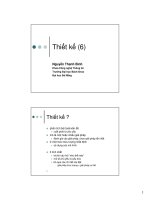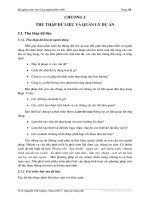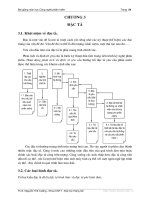Slide công nghệ phần mềm chương 5 system modeling
Bạn đang xem bản rút gọn của tài liệu. Xem và tải ngay bản đầy đủ của tài liệu tại đây (769.93 KB, 66 trang )
SOFTWARE
ENGINEERING
Chapter 5 – System Modelling
Jul 2013
Topics covered
• Context models
• Interaction models
• Structural models
• Behavioral models
• Model-driven engineering
Chapter 5. System modeling
2
Jul 2013
Chapter 5. System modeling
3
System modeling
• the process of developing abstract models of a system,
with each model presenting a different view or perspective
of that system.
• representing a system using some kind of graphical
notation, which is now almost always based on notations
in the Unified Modeling Language (UML).
• helps the analyst to understand the functionality of the
system and models are used to communicate with
customers.
Jul 2013
Chapter 5. System modeling
4
Existing and planned system models
• Models of the existing system
• are used during requirements engineering
• to help clarify what the existing system does and can be used as a
basis for discussing its strengths and weaknesses
• then lead to requirements for the new system.
• Models of the new system
• are used during requirements engineering
• to help explain the proposed requirements to other system
stakeholders
• Engineers use these models to discuss design proposals and to
document the system for implementation.
Jul 2013
Chapter 5. System modeling
5
System perspectives
• An external perspective
• model the context or environment of the system.
• An interaction perspective
• model the interactions between a system and its environment, or
between the components of a system.
• A structural perspective
• model the organization of a system or the structure of the data that
is processed by the system.
• A behavioral perspective
• model the dynamic behavior of the system and how it responds to
events.
Jul 2013
Chapter 5. System modeling
6
UML diagram types
• Activity diagrams
• show the activities involved in a process or in data processing .
• Use case diagrams
• show the interactions between a system and its environment.
• Sequence diagrams
• show interactions between actors and the system and between
system components.
• Class diagrams
• show the object classes in the system and the associations
between these classes.
• State diagrams
• show how the system reacts to internal and external events.
Jul 2013
Chapter 5. System modeling
7
Use of graphical models
• As a means of facilitating discussion about an existing or
proposed system
• Incomplete and incorrect models are OK as their role is to support
discussion.
• As a way of documenting an existing system
• Models should be an accurate representation of the system but
need not be complete.
• As a detailed system description that can be used to
generate a system implementation
• Models have to be both correct and complete.
Jul 2013
Chapter 5. System modeling
8
Context models
• Illustrate the operational context of a system
• show what lies outside the system boundaries
• Social and organisational concerns may affect the
decision on where to position system boundaries
• Architectural models show the system and its relationship
with other systems.
Jul 2013
Chapter 5. System modeling
9
System boundaries
• System boundaries are established to define what is
inside and what is outside the system.
• They show other systems that are used or depend on the system
being developed.
• The position of the system boundary has a profound effect
on the system requirements.
• Defining a system boundary is a political judgment
• There may be pressures to develop system boundaries that
increase / decrease the influence or workload of different parts of
an organization.
Jul 2013
Chapter 5. System modeling
The context of the MHC-PMS
10
Jul 2013
Chapter 5. System modeling
11
Process perspective
• Context models simply show the other systems in the
environment, not how the system being developed is used
in that environment.
• Process models reveal how the system being developed
is used in broader business processes.
• UML activity diagrams may be used to define business
process models.
Jul 2013
Chapter 5. System modeling
12
Process model of involuntary detention
Jul 2013
Chapter 5. System modeling
13
Interaction models
• Modeling user interaction is important as it helps to
identify user requirements.
• Modeling system-to-system interaction highlights the
communication problems that may arise.
• Modeling component interaction helps us understand if a
proposed system structure is likely to deliver the required
system performance and dependability.
• Use case diagrams and sequence diagrams may be used
for interaction modeling.
Jul 2013
Chapter 5. System modeling
14
Use case modeling
• Use cases were developed originally to support
requirements elicitation and now incorporated into the
UML.
• Each use case represents a discrete task that involves
external interaction with a system.
• Actors in a use case may be people or other systems.
• Represented diagramatically to provide an overview of the
use case and in a more detailed textual form.
Jul 2013
Chapter 5. System modeling
Transfer-data use case
• A use case in the MHC-PMS
15
Jul 2013
Chapter 5. System modeling
16
Tabular description of the ‘Transfer data’
use-case
MHC-PMS: Transfer data
Actors
Medical receptionist, patient records system (PRS)
Description
Data
A receptionist may transfer data from the MHC-PMS to a
general patient record database that is maintained by a
health authority. The information transferred may either
be updated personal information (address, phone
number, etc.) or a summary of the patient’s diagnosis
and treatment.
Patient’s personal information, treatment summary
Stimulus
User command issued by medical receptionist
Response
Confirmation that PRS has been updated
Comments
The receptionist must have appropriate security
permissions to access the patient information and the
PRS.
Jul 2013
Chapter 5. System modeling
17
Use cases in the MHC-PMS involving
the role ‘Medical Receptionist’
Jul 2013
Chapter 5. System modeling
18
Alternative Use-Case Scenarios
• Scenario
• A single sequence of steps
• No branching!!!
• Ex: Login use-case
• Main scenario
1. User enters username and password
2. User click “Login” button
3. System validates the username and password are correct
4. System change status of the user to “logged in”
• Alternative 1
4A. [Validating is not passed] System display an error message
• Alternative 2
2A. User click “Cancel” button
Jul 2013
Chapter 5. System modeling
Alternative Use-Case Scenarios
Use Case ID:
Use Case
Name:
Created By:
Date Created:
Actors:
Description:
Trigger:
Preconditions: 1.
Postconditions: 1.
Normal Flow: 1.
Alternative Flows:
Exceptions:
Includes:
Priority:
Frequency of Use:
Business Rules:
Special Requirements:
Assumptions:
Notes and Issues:
Last Updated By:
Date Last Updated:
19
Jul 2013
Chapter 5. System modeling
20
Alternative Use-Case Scenarios
• Actor: A member of the public (MP)
• Use case: The MP is searching for club events on a particular date.
• Preconditions: The MP is at the CIS home page, but not logged in as
a member.
• Scenario A:
•
•
•
•
•
•
1. MP selects “Search Events” on MP home page
2. System presents a page with choice of dates for the current month
3. MP selects a date from among the choices
4. System presents a page with events for that date, giving time and club name
5. MP selects an event
6. System presents a page with details of that event, including location,
description and cost
• Exception:
• 4. If there are no events for the selected date, System presents a page saying
that there are no events for the selected date
• Alternative Scenario A1:
• 3a. MP selects a different month
• 3b. System presents a page with choice of dates for the current month
Jul 2013
21
Chapter 5. System modeling
Advanced UML notations
<<extend>>
• Extend and Include
• Ex: Manage Users
<<extend>>
Browse the list of Users
Delete a User
<<extend>>
<<include>>
• Assumption
• Ex: Change User Name user-case
Login
Edit a User
Create a new User
• Assumption: User is logged in
1. User click “Change Name” menu item
2. System display “Change Name” form
3. User enters a new name
4. User hits “Confirm” button
5. System change the user name to the new name
Jul 2013
Chapter 5. System modeling
22
Sequence diagrams
• Sequence diagrams are part of the UML and are used to
model the interactions between the actors and the objects
within a system.
• A sequence diagram shows the sequence of interactions
that take place during a particular use case or use case
instance.
• The objects and actors involved are listed along the top of
the diagram, with a dotted line drawn vertically from
these.
• Interactions between objects are indicated by annotated
arrows.
Jul 2013
Chapter 5. System modeling
Sequence diagram for View patient
information
23
Jul 2013
Chapter 5. System modeling
24
Sequence diagram for Transfer Data
Jul 2013
Chapter 5. System modeling
25
Build a Sequence Diagram
• 1. Identify the use case whose sequence diagram you will
build
• 2. Identify which entity initiates the use case
• the user, or
myObject
:MyClass
• an object of a class
• name the class
• name the object
• 3. Draw a rectangle to represent this object at left top
• use UML object:Class notation
• 4. Draw an elongated rectangle beneath this to represent
the execution of an operation
• 5. Draw an arrow pointing right from it to indicate invoked
functionality









